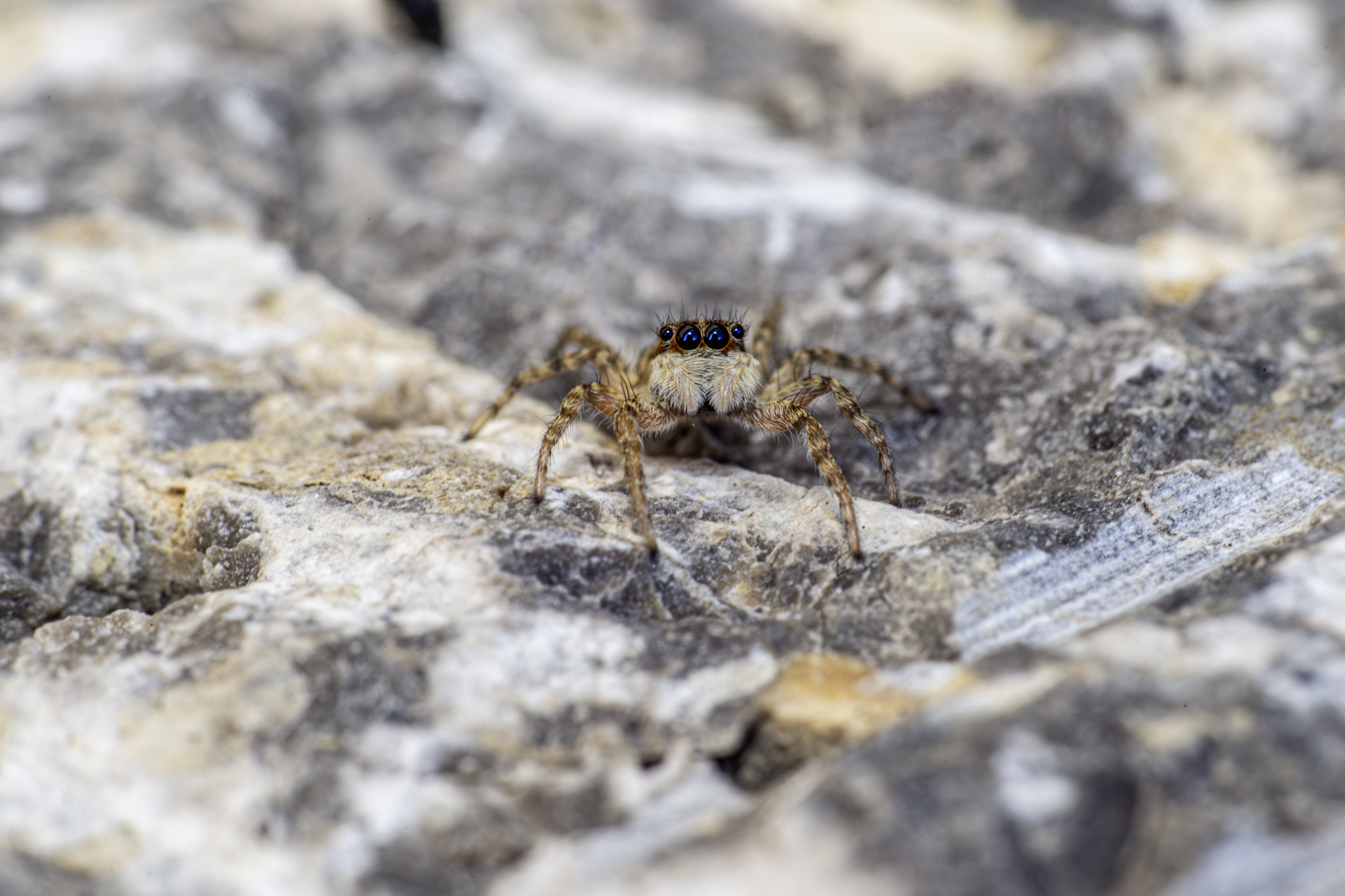Here’s a detailed overview of the Jumping Spider (Family Salticidae) — one of the most fascinating and visually striking spider families, known for their excellent vision and agile, cat-like hunting behavior.
🕷️ Jumping Spider (Family Salticidae)
Taxonomy
- Kingdom: Animalia
- Phylum: Arthropoda
- Class: Arachnida
- Order: Araneae
- Family: Salticidae
Common name: Jumping Spider
Scientific family name: Salticidae (from Latin saltare, “to jump”)
General Description
Jumping spiders are small to medium-sized spiders known for their remarkable vision, bold behavior, and distinctive jumping ability used for hunting and exploration.
- Size: 3–15 mm (some tropical species up to 25 mm)
- Body shape: Compact, with a short, stout body and relatively short legs
- Coloration: Exceptionally variable — from plain brown or black to metallic green, blue, or iridescent patterns.
- Eyes:
- 8 eyes total, with a large pair of forward-facing central eyes giving binocular vision and depth perception.
- Side and rear eyes detect motion and wide angles.
- Legs: Powerful hind legs used for precise jumps — up to 50 times their body length.
Distribution
Jumping spiders are the largest family of spiders in the world, with over 6,000 species across ~600 genera.
- Found on every continent except Antarctica.
- Especially diverse in tropical and subtropical regions.
- Common in Europe, Asia, and North America, including habitats from forests and grasslands to urban walls and gardens.
Habitat
Highly adaptable, jumping spiders live in nearly every terrestrial habitat:
- Leaf litter, bark, rocks, and foliage
- Tree trunks, grass stems, and flowers
- Human structures — windowsills, fences, walls
- Desert sand dunes, tropical rainforest leaves, and mountain meadows
They prefer sunny, open areas where they can actively hunt during the day.
Behavior and Ecology
Jumping spiders are diurnal visual hunters — unlike web-building spiders, they stalk and leap onto prey.
- Movement: Quick, alert, and curious. Often turn to look at observers.
- Hunting:
- Use sight to locate and judge distance to prey.
- Leap precisely using hydraulic pressure in their legs.
- Secure themselves with a silk dragline before jumping.
- Diet:
- Small insects and other arthropods (flies, aphids, ants, etc.)
- Some species are omnivorous or even nectar-feeding.
- Web use:
- No capture webs.
- Build silken shelters for resting, molting, or egg-laying.
Reproduction
- Courtship:
- Males perform complex dances and visual displays, often waving colored legs or vibrating body parts to impress females.
- Some species have brightly colored scales, like miniature peacocks (Maratus spp.).
- Egg laying:
- Females spin a silken retreat where they lay eggs in a cocoon.
- Guard the egg sac until spiderlings hatch.
- Lifespan: Usually 1–2 years.
Vision
Jumping spiders have some of the best vision among invertebrates:
- Their large anterior median eyes provide high-resolution, color, and depth vision.
- They can track moving prey and recognize mates or rivals.
- Many species can even see in ultraviolet light, useful for identifying patterns invisible to humans.
Defensive Behavior
- Prefer escape and jumping to confrontation.
- Some species mimic ants or beetles for camouflage or defense (ant-mimicking spiders, Myrmarachne spp.).
- When threatened, they may raise their front legs or jump away rapidly.
Common Species (Examples)
| Common Name | Scientific Name | Range |
|---|---|---|
| Zebra Jumping Spider | Salticus scenicus | Europe, North America |
| Bold (Daring) Jumping Spider | Phidippus audax | North America |
| Peacock Spider | Maratus volans | Australia |
| Evarcha arcuata | Eurasia | |
| Evarcha falcata | Europe, Asia | |
| Carrhotus xanthogramma | Europe to Asia Minor |
Predators
- Birds, lizards, frogs, and larger spiders.
- Despite their size, they often avoid predation through agility and camouflage.
Ecological Role
- Important natural pest controllers, feeding on flies, mosquitoes, and other small insects.
- Serve as prey for many insectivores, linking trophic levels in ecosystems.
Identification Summary
| Feature | Description |
|---|---|
| Size | 3–15 mm |
| Eyes | 8, with large central pair |
| Color | Brown, black, metallic, or patterned |
| Behavior | Diurnal, active hunter |
| Movement | Agile jumping, curious turning |
| Web | No capture web; silk retreat only |
| Diet | Insects and other arthropods |
| Vision | Excellent, color and depth perception |
Interesting Facts
- Jumping spiders can leap up to 40–50 times their body length.
- The “Zebra Jumping Spider” (Salticus scenicus) often lives on building walls and window ledges in Europe.
- The Peacock Spiders of Australia are world-famous for their vibrant courtship dances.
- Some tropical species (e.g., Bagheera kiplingi) are partly vegetarian, feeding on acacia plant parts.
- They don’t rely on webs — they are active, intelligent hunters that explore their environment visually.
Conservation Status
- IUCN status: Most species – Least Concern
- Widespread and abundant, though habitat loss may affect some specialists.
Views: 1492
Subscribe to the newsletter:
